It looks like you're using an Ad Blocker.
Please white-list or disable AboveTopSecret.com in your ad-blocking tool.
Thank you.
Some features of ATS will be disabled while you continue to use an ad-blocker.
share:
reply to post by beansidhe
i think all the stories lead back to the original
the gods are the ones who survived the flood and caused civilization to reboot - the master race of aryans - goth...
the sumerians and egyptians, and later the picts, and the mayans, for example were all peoples that were recivilized because they could be
and they had resources...
thus you get the halfnhalf god/man people like Paris and Achilles at troy which happened in Pictish Britian..
and not homers troy as in the greek version.
you get thirty thousand kinds of christians off one mistaken myth, and even if there was a truth to it....
you still have thirty thousand kinds of christians off one myth
thats crazy....
long and short
the nephalim came down off a mountian in ANatolia where the mountain rteached up to hEAven...
they had this cross...and some sciences
they handed down laws written in stone from ziggurats...
then you get like the tower of babal...
...
kishi manishtusu...gichi manitou
i think all the stories lead back to the original
the gods are the ones who survived the flood and caused civilization to reboot - the master race of aryans - goth...
the sumerians and egyptians, and later the picts, and the mayans, for example were all peoples that were recivilized because they could be
and they had resources...
thus you get the halfnhalf god/man people like Paris and Achilles at troy which happened in Pictish Britian..
and not homers troy as in the greek version.
you get thirty thousand kinds of christians off one mistaken myth, and even if there was a truth to it....
you still have thirty thousand kinds of christians off one myth
thats crazy....
long and short
the nephalim came down off a mountian in ANatolia where the mountain rteached up to hEAven...
they had this cross...and some sciences
they handed down laws written in stone from ziggurats...
then you get like the tower of babal...
...
kishi manishtusu...gichi manitou
edit on 2-3-2014 by Danbones because: (no reason given)
reply to post by Danbones
I'm honestly not trying to be obtuse, I'm just not particularly familiar with religious books! I grew up with a Highland mother, who still calls the New Testament 'nonsense', and the Old Testament the 'real bible' and a Catholic father, who claims to be an atheist, but who has some very bizarre concepts for an atheist! (Such as there must be a God).
So, ok, I understand your history, and I suppose I'm wondering why the Picts would claim, or rather the Irish chroniclers would claim that Cruichne was a descendant of Noah? Irrespective of what the real story is, because they seem to be using a biblical family tree. Maybe it can't be separated from the Babylonian story, and I'm just not seeing that.
Was it for prestige, was it their real royal line, was it an allegory for something, was it to ridicule them?
When you're talking about religion to me, please pitch it the level you might use if you were explaining it to, say a turnip, for example.
I'm honestly not trying to be obtuse, I'm just not particularly familiar with religious books! I grew up with a Highland mother, who still calls the New Testament 'nonsense', and the Old Testament the 'real bible' and a Catholic father, who claims to be an atheist, but who has some very bizarre concepts for an atheist! (Such as there must be a God).
So, ok, I understand your history, and I suppose I'm wondering why the Picts would claim, or rather the Irish chroniclers would claim that Cruichne was a descendant of Noah? Irrespective of what the real story is, because they seem to be using a biblical family tree. Maybe it can't be separated from the Babylonian story, and I'm just not seeing that.
Was it for prestige, was it their real royal line, was it an allegory for something, was it to ridicule them?
When you're talking about religion to me, please pitch it the level you might use if you were explaining it to, say a turnip, for example.
reply to post by beansidhe
Here is something for you now...
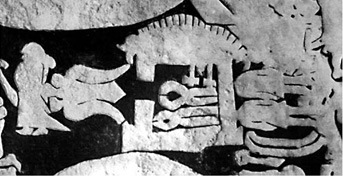
Center mass there.....said to be smith tools, smithy tools, according to Andre Stones.
Pictish Stone
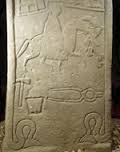
These Pictish stones are also recognized as representing forging tools, hammer, anvil, tongs. Now with the Andre stones being of a certain nature we could safely say this part of the mystery is solved. I think someone else back a few pages, lol, made a similar observation.
Andre Stones
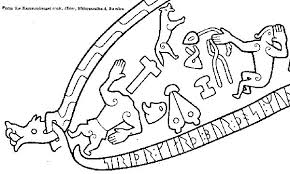
Ransund Rune
Waylands Story
Here is something for you now...

Center mass there.....said to be smith tools, smithy tools, according to Andre Stones.
Pictish Stone

These Pictish stones are also recognized as representing forging tools, hammer, anvil, tongs. Now with the Andre stones being of a certain nature we could safely say this part of the mystery is solved. I think someone else back a few pages, lol, made a similar observation.
Andre Stones

Ransund Rune
Waylands Story
edit on 3-3-2014 by Logarock because: n
reply to post by beansidhe
Now for another fine pain in the ass.....Pictish Winged person....upper left.

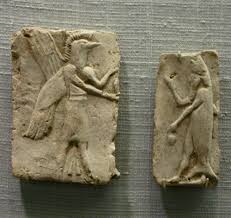
Syrian Winged person right. Its hard to tell from this distance but doesn't the Pict figure also sport the bird head?
Full Figure.
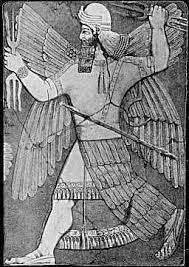
We have seen the Syrian style winged disk in one Pictish stone, lower left.
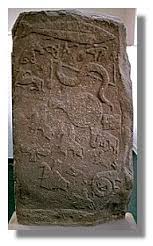
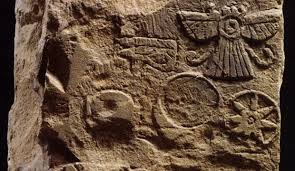
Syrophoenician right.
It looks more and more to me like the Pictish stones represent intrusions, influences, ect over a larger period of time that is believed commonly, although not drifting to far from style. Whoever may have been controlling the area as a vassal for larger interest, these interest and influences changed as the larger controlling elements shifted with the changing fortunes back at the ranch.
Now for another fine pain in the ass.....Pictish Winged person....upper left.


Syrian Winged person right. Its hard to tell from this distance but doesn't the Pict figure also sport the bird head?
Full Figure.

We have seen the Syrian style winged disk in one Pictish stone, lower left.


Syrophoenician right.
It looks more and more to me like the Pictish stones represent intrusions, influences, ect over a larger period of time that is believed commonly, although not drifting to far from style. Whoever may have been controlling the area as a vassal for larger interest, these interest and influences changed as the larger controlling elements shifted with the changing fortunes back at the ranch.
edit on 3-3-2014 by Logarock because: n
reply to post by Logarock
Lol is right! Er, I mean...oh well!
Looks like they're having the same problem!
The Eassie Stone that you've shown - it's hard to say, but we've seen bird-headed figures before. That stone is too chipped to be sure.
I think I need to loosen up my understanding of 'Picts'. There is a whole range of cultures being depicted (no pun intended).
Agreed, the current timescales must be way out. These stones are telling us who's around and who has the power as well as their specific message.
And look under the winged person - a double disc!
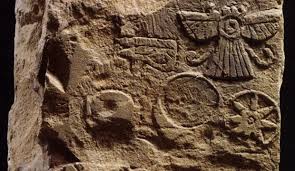
Lol is right! Er, I mean...oh well!
The largest and most famous of the stones is the Ardre VIII stone, dated to the 8th[1] or 9th century, depicts scenes from Norse mythology, notably the Lay of Weyland the smith, Thor fishing for Jörmungandr, the punishment of Loki for the death of Baldr,[2] and Odin riding to Valhalla on Sleipnir. Other images on this stone, such as the woman on the right with two swords, are not currently understood as they do not conform to any known Norse myth that has survived to the present time.[
Looks like they're having the same problem!
The Eassie Stone that you've shown - it's hard to say, but we've seen bird-headed figures before. That stone is too chipped to be sure.
I think I need to loosen up my understanding of 'Picts'. There is a whole range of cultures being depicted (no pun intended).
Agreed, the current timescales must be way out. These stones are telling us who's around and who has the power as well as their specific message.
And look under the winged person - a double disc!

reply to post by beansidhe
i think a lot of people have been had...
the story of troy is a good example...the greek version... and the actual find..in Briton
how much of what people believe of history is based on misconceptions like that?
there are over thirty thousand different kinds of christians
and I'm just as confused as you are about which one is the one true faith...but none know of the real use of the cross
so, I'll see your turnip and raise you a rootabaga
eta
www.landofpyramids.org...
there are several symbols we have seen in the pictish stones here in the crowns of egypt..keep in mind amun is amen... menes...his headress/crown is two feathers.
i think a lot of people have been had...
the story of troy is a good example...the greek version... and the actual find..in Briton
how much of what people believe of history is based on misconceptions like that?
there are over thirty thousand different kinds of christians
and I'm just as confused as you are about which one is the one true faith...but none know of the real use of the cross
so, I'll see your turnip and raise you a rootabaga
eta
www.landofpyramids.org...
there are several symbols we have seen in the pictish stones here in the crowns of egypt..keep in mind amun is amen... menes...his headress/crown is two feathers.
edit on 3-3-2014 by Danbones because: (no reason given)
reply to post by beansidhe
Logarock, I was looking for the source of your stone, and found it in Saudi. It's quite telling and I think pretty much sums up where we are, too:

Roads of Arabia
Logarock, I was looking for the source of your stone, and found it in Saudi. It's quite telling and I think pretty much sums up where we are, too:

A more vivid illustration of Tayma’s patchwork of assimilated cultures is epitomized by another sculpture, the so-called “al-Hamra cube,” named for the sanctuary where it was found, and chiseled around a century after Nabonidus, in the fifth or fourth century bce. André-Salvini ticks off its syncretic elements: a “thoroughly Babylonian” priest standing before an altar to the Egyptian bull-god Apis, set against a background of winged emblems and an eight-pointed star that is probably derived from Anatolian civilization. “Despite borrowing imagery from other cultures, the art is totally unique,” she explains. “It possesses a seminal Arabic identity that’s neither Mesopotamian nor Egyptian nor Syrian.”
Even though she is an expert, André-Salvini admits that she too was staggered by the variety and the wealth of the finds. “The history of Saudi Arabia is made from contact with surrounding civilizations,” she explains. “But in spite of these foreign influences, everything from outside was absorbed and reinterpreted in an unmistakably original fashion.”
Roads of Arabia
reply to post by Danbones
I had to google rootabaga!
Well, everything should become clearer now we know that we're not looking for one unified set of symbols, but interpreting a range of cultural icons over a period of around 2-3 thousand years.
Lol!
I had to google rootabaga!
Well, everything should become clearer now we know that we're not looking for one unified set of symbols, but interpreting a range of cultural icons over a period of around 2-3 thousand years.
Lol!
beansidhe
reply to post by Logarock
Lol is right! Er, I mean...oh well!
The largest and most famous of the stones is the Ardre VIII stone, dated to the 8th[1] or 9th century, depicts scenes from Norse mythology, notably the Lay of Weyland the smith, Thor fishing for Jörmungandr, the punishment of Loki for the death of Baldr,[2] and Odin riding to Valhalla on Sleipnir. Other images on this stone, such as the woman on the right with two swords, are not currently understood as they do not conform to any known Norse myth that has survived to the present time.[
Looks like they're having the same problem!
Yes they are! To what you quoted above, the mixture of known with the unknown suggests that the actual stone workers, stone scribes were always of the same order simply recording events and familiar with sets of iconic representative style. Which although fairly obvious is hard to understand. Maybe the druids? There had to have been some sort of guild that was serious about the craft.
reply to post by Logarock
A guild of stone masons? Who recorded events, but who incorporated the prevailing iconography into the existing symbology of the area, irrespective of religion?
Who may or may not have been Druids and keepers of knowledge?
Nope, sorry, that doesn't sound likely, at all.
I'm only sort of joking.
A guild of stone masons? Who recorded events, but who incorporated the prevailing iconography into the existing symbology of the area, irrespective of religion?
Who may or may not have been Druids and keepers of knowledge?
Nope, sorry, that doesn't sound likely, at all.
I'm only sort of joking.
beansidhe
reply to post by beansidhe
Logarock, I was looking for the source of your stone, and found it in Saudi. It's quite telling and I think pretty much sums up where we are, too:
A more vivid illustration of Tayma’s patchwork of assimilated cultures is epitomized by another sculpture, the so-called “al-Hamra cube,” named for the sanctuary where it was found, and chiseled around a century after Nabonidus, in the fifth or fourth century bce. André-Salvini ticks off its syncretic elements: a “thoroughly Babylonian” priest standing before an altar to the Egyptian bull-god Apis, set against a background of winged emblems and an eight-pointed star that is probably derived from Anatolian civilization. “Despite borrowing imagery from other cultures, the art is totally unique,” she explains. “It possesses a seminal Arabic identity that’s neither Mesopotamian nor Egyptian nor Syrian.”
Even though she is an expert, André-Salvini admits that she too was staggered by the variety and the wealth of the finds. “The history of Saudi Arabia is made from contact with surrounding civilizations,” she explains. “But in spite of these foreign influences, everything from outside was absorbed and reinterpreted in an unmistakably original fashion.”
Roads of Arabia
The History of Israel often left out of an equation like this, come to mind. Although they had their own thing going on, they were neck deep in all the surrounding kingdoms big and small. They came out of Egypt and never broke off this historical tie, they absorbed Canaan and all of the city/tribal states there, they fought and commerced with Syria for centuries. Real good pals with the Phoenicians and so much so that at a point the tribe of Dan become hard to distinguish from the Phoenicians who had taught them the ways of the high seas. They were finally destroyed by the Syrians and the Babylonians and taken away large scale to these lands.
Anyway their own history makes it clear that their culture was well familiar with all the gods and customs of all the surrounding nations. From Ball of the Canaanites, to the Queen of heaven, Oak Grove cults you name it they absorbed it. Did I just say Oak Grove? Sound familiar? Some have speculated that this was the origins of the Druids that came out of the corrupted order of priests that the Israelites had in place to oversee the worship of Yahweh.
Back to the tribe of Dan. There are good studies out there that claim this tribe became so great on the sea that they account for all the river names in Europe and place names like Dunkirk, Danube, Denmark ect ect....anytime you see Den, Dun, Don, ect its a place they claimed and marked with their tribal name in Ireland, Britain, Europe, ect. Its very interesting. Even places like Donegal the set of the old Irish kings. Anyway these Dannites set many of their country men in outposts all over the place. A lot of folks know about Solomon the great king but few know he had a large navy and his own fleet of trading vessels courtesy of the same folks that help him build his temple. And that was early on in dynastic history. They had already lived in that land for a good while before that.
Point being that this may account for a culture that had its on way of doing things but were accustomed to incorporating accurate cross cultural icons.
edit on 3-3-2014 by Logarock because: n
masons like Beauregard the designer of my AV..a mason, knights templar, and engineer...there is the stars the cross and pyramids...
Druids certainly must have played a part
sorry for the long quote
I just had to
Druids certainly must have played a part
sorry for the long quote
I just had to
www.britannia.com...
Evidence of Celtic culture appears in Britain from the second millennium B.C., and it is now suggested that the Celtic priesthood could have been responsible for the Stonehenge temple, built in about 2000 B.C.
Celtic society in Britain preserved many features from the previous order, including shrines and feast days. Its calendar combined lunar and solar cycles, as in megalithic times. The social structure was similar to that advocated by Plato, based on a religious cosmology and democratic idealism. Each tribe had its own territory with fixed borders, and that land, held by the tribe as a whole, consisted of forest and wilderness, common lands and agricultural holdings.
Under a complicated system of land tenure, everyone's rights and obligations were carefully defined. Some of the land was worked in common for the chieftain, the priests, and the old, poor, and sick tribesfolk; the rest was apportioned as family farms. Grazing and foraging rights were shared on the common lands. Much of the tribal business was conducted at annual assemblies where land disputes were decided, petty offenders were tried, and chiefs and officials, both male and female, were appointed by popular vote.
A great many old farmsteads in Britain, today, are on Celtic sites. During his raid on Celtic Britain in 55 B.C., Julius Caesar commented on its high population and numerous farms and cattle. The unifying bond between all the Celtic tribes was their common priesthood, the Druids. Their efforts preserved common culture, religion, history, laws, scholarship, and science. They had paramount authority over every tribal chief and, since their office was sacred, they could move where they wanted. settling disputes and stopping battles by compelling the rival parties to arbitration.
They managed the higher legal system and the courts of appeal, and their colleges in Britain were famous throughout the Continent. Up to twenty years of oral instruction and memorizing was required of a pupil before being admitted into their order. Minstrels and bards were educated by the Druids for similar periods.
Knowledge of the Druids comes directly from classical writers of their time. They were compared to the learned priesthoods of antiquity, the Indian Brahmins, the Pythagoreans, and the Chaldean astronomers of Babylon. Caesar wrote that they
"know much about the stars and celestial motions, and about the size of the earth and universe, and about the essential nature of things, and about the powers and authority of' the immortal gods; and these things they teach to their pupils."
They also taught the traditional doctrine of the soul's immortality. They must have professed detailed knowledge of the workings of reincarnation, for one writer said that they allowed debts incurred in one lifetime to be repaid in the next.
A significant remark of Caesar's was that Druidism originated in Britain, which was its stronghold. Indeed, it has all the appearance of a native religion, being deeply rooted in the primeval native culture. Its myths and heroic legends are related to the ancient holy places of Britain, and they may largely have been adapted from much earlier traditions. In Celtic, as in all previous times, the same holy wells and nature shrines were visited on certain days for their spiritual virtues. The overall pattern of life was scarcely changed. In the course of time, society became more structured and elaborate and the Druid laws more rigid, but the beginning of the Celtic period in Britain was evidently not marked by any major break in tradition.
Nor was there any great shift in population; the British today, even in the so-called Celtic lands, are predominantly of native Mesolithic ancestry. The Druids' religion and science also have the appearance of belonging to an earlier Britain. Their knowledge of astronomy may have descended from the priests of megalithic times, together with the spiritual secrets of the landscape.
edit on
3-3-2014 by Danbones because: (no reason given)
edit on 3-3-2014 by Danbones because: (no reason given)
Dan..what about...
www.bibliotecapleyades.net...
instead of aliens, read offspring of aryans..like achilles and paris etal at the battle of troy...in britian
if the ark is a sumerian story as the post i made earlier indicates and then noah was actually the sumerian guy...
2000 years earlier...
ummm, i wonder what that means to the god of the jews, and christians...
The Tuatha De Danann, also known as...
The Dragon Lords of Anu
...because they were said to be the offspring of the fallen angels (Anunnaki)
www.bibliotecapleyades.net...
instead of aliens, read offspring of aryans..like achilles and paris etal at the battle of troy...in britian
if the ark is a sumerian story as the post i made earlier indicates and then noah was actually the sumerian guy...
2000 years earlier...
ummm, i wonder what that means to the god of the jews, and christians...
edit on 3-3-2014 by Danbones because: (no reason given)
reply to post by Logarock
You know that the two main rivers in Aberdeen are the Don and the Dee? The Don runs from the Grampians out to sea.
River Don
The tribe of Dan? As in Tuatha de Danaan?
You know that the two main rivers in Aberdeen are the Don and the Dee? The Don runs from the Grampians out to sea.
River Don
The tribe of Dan? As in Tuatha de Danaan?
from my link above
phonecians...?
www.bibliotecapleyades.net...
phonecians...?
By far the most interesting of the peoples that formerly inhabited Ireland were the Tuaths, or Tuatha de Danaans, or Dananns. There is much mystery about them in Irish traditions. They were men, gods, or fairies.
They came, of course, from the East, calling in at Greece on the way, so as to increase their stock of magic and wisdom. Some trace them to the tribes of Dan, and note Dedan in Ezek. xxv. 13.
Mrs. Wilkins identifies them with the Dedanim of Isa. xxl. 13,
"a nomad, yet semi-civilized, people." Isaiah calls them "travelling companies of Dedanim."
The credulous Four Masters have wonderful tales of Tuath doings. In their invasion of Ireland, Tuaths had to deal with the dark aborigines, known as the Firbolgs, and are said to have slain 100,000 at the battle of Magh-Tuireadh Conga. Driven off the island by their foes, they traveled in the East, returning from their exile as finished magicians and genuine Druids.
Mr. Gladstone, in Juventus Mundi, contends that Danaan is of Phœnician extraction, that a district near Tripoli, of Syria, is known as Dannié.
He adds,
"Pausanias says that at the landing-place of Danaos, on the Argive coast, was a temple of Poseidon Genesios, of Phœnician origin."
After reigning in Ireland two hundred years, the Tuatha were, it is narrated, invaded by the children of Gail Glas, who had come from Egypt to Spain, and sailed thence to Erin under Milesius, the leader of the Milesians. When their fleet was observed, the Danaans caused a Druidic fog to arise, so that the land assumed the shape of a black pig, whence arose another name for Ireland: "Inis na illuic, or Isle of the Pig."
www.bibliotecapleyades.net...
reply to post by Danbones
They must have communicated with someone to have such wide-ranging, global, knowledge. They didn't just make it up coincidentally, the same as everyone else. That's an awful lot of things to know about.
Knowledge of the Druids comes directly from classical writers of their time. They were compared to the learned priesthoods of antiquity, the Indian Brahmins, the Pythagoreans, and the Chaldean astronomers of Babylon. Caesar wrote that they ...
They must have communicated with someone to have such wide-ranging, global, knowledge. They didn't just make it up coincidentally, the same as everyone else. That's an awful lot of things to know about.
reply to post by beansidhe
yeah like they were the secret society mason priests of the day...
i think that a part of this is we are looking at a progression of keepers of the keys to the knowledge that was preserved from pre antiquity...from atlantis even..which looks to been world wide back in the day
yeah like they were the secret society mason priests of the day...
i think that a part of this is we are looking at a progression of keepers of the keys to the knowledge that was preserved from pre antiquity...from atlantis even..which looks to been world wide back in the day
edit on 3-3-2014 by Danbones because: (no reason given)
reply to post by Logarock
It is an obvious point, and yet it is incredibly subtle - and easy to miss. I was thinking backwards, about preserving the symbols through time, rather than adapting and incorporating new ones, in keeping with the very specific 'Picty' style.
I have to go just now, but this is good stuff!!
Point being that this may account for a culture that had its own way of doing things but were accustomed to incorporating accurate cross cultural icons.
It is an obvious point, and yet it is incredibly subtle - and easy to miss. I was thinking backwards, about preserving the symbols through time, rather than adapting and incorporating new ones, in keeping with the very specific 'Picty' style.
I have to go just now, but this is good stuff!!
reply to post by Danbones
Bones, the Hebrew history is clear that Noah....was related to the Sumerians as was Abraham. In fact Hebrew scripture even refers to the Tigris Euphrates headwaters as the actual land of nativity for the Hebrew people. When the Syrians kick their asses that's where they carted them off to....the lands north of Syria, their original homeland. That's the northern half of Israle, the southern being carted off under the Babylonians.
The problems that occurred in Sumeria had to do with the descendants of Noah's sons having a dispute about God. LOL You are not going to surprise me with any of this stuff. Its only confusing to folks that don't know the history. Don't you remember the story? God told Abraham to get out of Sumeria, the land of his fathers. Every Sunday school boy knows that story.
Bones, the Hebrew history is clear that Noah....was related to the Sumerians as was Abraham. In fact Hebrew scripture even refers to the Tigris Euphrates headwaters as the actual land of nativity for the Hebrew people. When the Syrians kick their asses that's where they carted them off to....the lands north of Syria, their original homeland. That's the northern half of Israle, the southern being carted off under the Babylonians.
The problems that occurred in Sumeria had to do with the descendants of Noah's sons having a dispute about God. LOL You are not going to surprise me with any of this stuff. Its only confusing to folks that don't know the history. Don't you remember the story? God told Abraham to get out of Sumeria, the land of his fathers. Every Sunday school boy knows that story.
beansidhe
reply to post by Danbones
Knowledge of the Druids comes directly from classical writers of their time. They were compared to the learned priesthoods of antiquity, the Indian Brahmins, the Pythagoreans, and the Chaldean astronomers of Babylon. Caesar wrote that they ...
They must have communicated with someone to have such wide-ranging, global, knowledge. They didn't just make it up coincidentally, the same as everyone else. That's an awful lot of things to know about.
The Druids may have had a wider range being present where ever Celts and their associated tribes were. Celts were all over the place. Northern Italy, Spain, ect pockets around the northern med area. They were so large and spread out so far they had constant contact with every civilization and emerging power in Europe. They were mercenaries' for just about everybody at one time or another.
new topics
-
Spiritual Solstice
Short Stories: 1 hours ago
top topics
-
'Mass Casualty event' - Attack at Christmas market in Germany
Mainstream News: 12 hours ago, 26 flags -
Biden Nationalizes Another 50,000+ Student Loans as He Heads for the Exit
US Political Madness: 16 hours ago, 8 flags -
Search to Resume for MH 370
Disaster Conspiracies: 14 hours ago, 5 flags -
Sue Gray, Sir Keir Starmer's former Chief of Staff, Nominated for Peerage
Regional Politics: 15 hours ago, 3 flags -
Spiritual Solstice
Short Stories: 1 hours ago, 0 flags
active topics
-
'Mass Casualty event' - Attack at Christmas market in Germany
Mainstream News • 102 • : BrucellaOrchitis -
Search to Resume for MH 370
Disaster Conspiracies • 8 • : charlyv -
Spiritual Solstice
Short Stories • 2 • : Naftalin -
Mood Music Part VI
Music • 3752 • : BrucellaOrchitis -
An Interesting Conversation with ChatGPT
Science & Technology • 31 • : BrucellaOrchitis -
Why isn't Psychiatry involved?
Social Issues and Civil Unrest • 28 • : BrucellaOrchitis -
Smartest Man in the World Tells His Theory About What Happens At Death
Philosophy and Metaphysics • 51 • : whereislogic -
Drones everywhere in New Jersey ---and Elsewhere Master Thread
Aliens and UFOs • 205 • : GENERAL EYES -
-@TH3WH17ERABB17- -Q- ---TIME TO SHOW THE WORLD--- -Part- --44--
Dissecting Disinformation • 3771 • : 777Vader -
Democrat Governors Hold Emergency Meeting With President Biden to Assess His Mental State.
2024 Elections • 119 • : TruthJava
